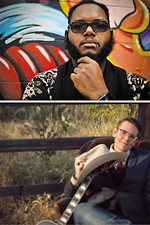Who You Callin' a Bear?
It's a Bear Nation, we're just living in it.
By Andy Campbell, 2:44PM, Fri. Mar. 26, 2010
We fell in love with Malcolm Ingram when he made Small Town Gay Bar, a little jewel of a documentary that meditates on living as a rural queer. For this year’s SXSW Ingram was back in the saddle with his new documentary, Bear Nation, which is about those beefy, be-bearded gay dudes who self-identify as “bears”. So how’d this one measure up? Read on …
The first act of Bear Nation is rapturous, possibly because it is so well-sited in the bear community of Toronto. Here we see bears in their native habitat working at record stores, making a living as teachers, and at home doing the dishes with their bear boyfriends. The interviews are highly aestheticized with subjects facing off camera and meandering in and out of focus. I loved this as it broke with the talking head format, highlighting the vulnerability of the men who share their identities with us. Stories flow from these men like the River Jordan. This is truly one of Ingram’s gifts; he puts his subjects at ease while coaxing out every detailed emotional truth – juicy or depressing. We learn that bears come out twice (like leather folks or the polyamorous) – first as queer, and then as bears. The tales of these men coming to terms with themselves and their own desires is riveting. This sort of thing when done honestly never gets old. Self-revelation is in great supply here, and the humor and panache of these bears even when they’re denigrating other segments of the queer community, is admirable. There is also a great diversity of bears in the first act: bears of color, bears of middle or working class, bear creatives, femme-y bears, and sheltered bears. It is the fullness of the community that speaks in the opening third of Bear Nation.
Too bad the following two acts don’t find a home in the careful nest Ingram manages to construct. Perhaps this is ultimately a problem of situating the documentary. We move from Toronto (“home base”) to bear conventions in two other cosmopolitan cities, Chicago and London. While conventions and conferences are one aspect of bear life, they hardly deserve the amount of time that Ingram affords them. Why? Well, because conventions become like circuit parties, only available to those that can afford them – therefore the community becomes highly self-selecting, even if there are those within it that don’t mean to be. Gone are the creatives, and the middle-lower or working class bears. Gone is the diversity in phenotype and in worldview. Gone are the sissy bears. Or if they aren’t gone we certainly don’t see them in this segment of Bear Nation. Yes there is hanky-panky in the hospitality suite of the host hotel and more dance parties than you can shake a moist towelette at, but my interest in these events was tepid at best. The major point of tension seems to be over whether a bear should be big-boned or toned – they can be either, but there are those with body preferences even within the loving embrace of the bear community.
The third act features an extended interview with Bear Nation’s producer, Kevin Smith, who is arguably one of the most articulate voices in the latter part of the film – at least he’s the only (straight) bear who isn’t drunk or waiting in a hotel lobby. This is too bad because it begins to feel like Ingram and Smith are making their case for straight-guy acceptance of the bear attitude. What they both miss is, while it’s not the norm, there is a widespread embrace of big, hairy masculine guys within gay and straight cultures. Ingram doesn’t intimate this in the film, but he knows it. When asked in the Q&A if bear culture was being coopted by culture at large Ingram’s answer was an immediate an emphatic “Yes!” Voila! Instant stakes! Bear communities are important to consider because they inform contemporary modes of masculinity. Instead you walk away from the film thinking that bear communities are important because they throw great parties. Hurrah? Speaking of the Q&A, Ingram was grilled after the premiere screening as to why there was no history of the bear movement present in the doc, why there weren’t more bears of color, and why there isn’t a discussion of the health risks bears face when they opt to live out their fantasy lives. All good questions, all hard questions – and there were no answers presented by the film. Why was there no history presented (FYI The bear movement began as an offshoot of leather communities in San Francisco)? Ingram’s answer was that he just didn’t go to San Francisco – which is fine, actually. Ingram’s role seemed to be keyed towards documenting the current state of bear culture and not towards archiving bear history. Why aren’t there more bears of color? This could be because bears of color don’t feel like they “fit” the bear mold – especially when being a bear means going to conventions in cities with other bears who are largely white. This isn’t Ingram’s problem, I think it’s ultimately the (white) bear community’s bugaboo, but Ingram’s task is to point to these places. It's not a pleasant aspect of bear culture but it's there. Why isn’t there a discussion of the health risks faced by these men? Well, that may be a trickier question, and one that body positive guys might not be willing to talk about. One can be big and healthy, but some are not. The question posed to Ingram wasn’t about pointing the nagging finger at bears and telling them to slim down, instead this question is about an honest portrayal of the lives bears lead – including issues with heart conditions, cholesterol, and respiratory issues (especially sleep apnea).
Most heartening was the audience that came to see Bear Nation. Lined up beside the badge and pass holders were a slew of Austin bears, ready to see their community reflected back to them onscreen. I was glad to see they made it in (as many non badge/pass holders couldn’t make opening screenings due to capacity), and SXSW is to be thanked for this. Their support of subcultural documentaries is unparalleled – and support means not only programming docs like Bear Nation, but giving them ample space for large numbers of people to see them. It was a risk to program Bear Nation, and despite its issues, it is a risk well taken. While Ingram might want to up the gravitas of the second and third acts, he has an enormously generative (and generous) first act. Overall the film is a love letter to a community Ingram finds himself to be a part of, and like a love letter it may be myopic, but the passion is surely there.
A note to readers: Bold and uncensored, The Austin Chronicle has been Austin’s independent news source for over 40 years, expressing the community’s political and environmental concerns and supporting its active cultural scene. Now more than ever, we need your support to continue supplying Austin with independent, free press. If real news is important to you, please consider making a donation of $5, $10 or whatever you can afford, to help keep our journalism on stands.
Richard Whittaker, June 7, 2018
Chronicle Film Staff, May 3, 2018
Carys Anderson, Feb. 27, 2024
Joelle DiPaolo, Feb. 23, 2023
Nov. 4, 2015
Film, SXSW, Gay, Bear, Malcolm Ingram, Bear Nation, Small Town Gay Bar, Toronto Gay, Chicago Bear, London Bear, Femme Bear, Bears of Color













